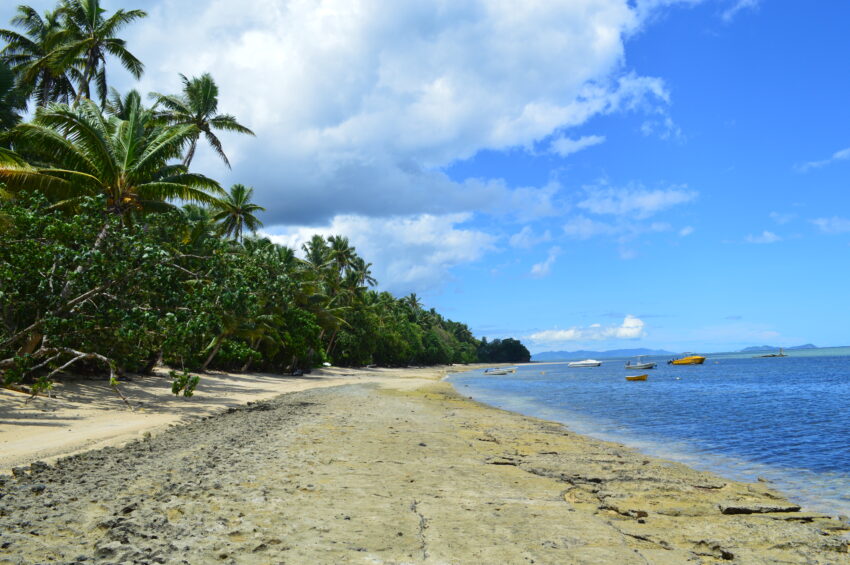
Fiji’s Responsible Development: the Youngest Citizens Lead the Way
By Andrea Clemett
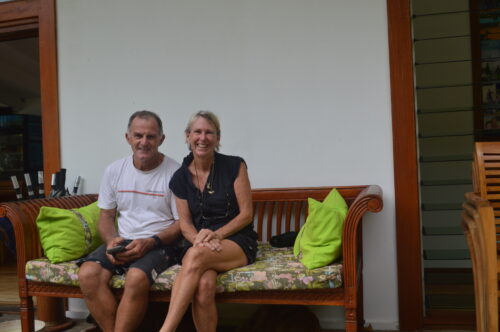
One of the main islands in Fiji is Viti Levu located in a sea of more than 300 islands. The large island draws in tourists to experience the vibrant coral beaches and dense greenery.
Located one to two hours from the international airport, Nadi, the coral coast stretches 80 km (50 miles) along the southern perimeter of the island.
Many villages border the coastal edge of the lined palms and there are often neighboring resorts tucked away in lavish vegetation.
When I first researched advice for sustainable travelers, I found articles that suggested taking direct flights and staying at eco accommodations that do more than post a green-washing label.
During the pandemic, islands like Namotu in Fiji had adjusted to self-sustaining without reliance on imported goods.
It seemed that on many islands impacts were lessened by the absence of tourists. I set out on my quest to find a moderately priced adventure that would have a low carbon footprint on the recently opened chain of islands.
The first step, fly direct to Nadi from LAX, the next step stay at only sustainable accommodations, and finally, the literal component, is not to set foot on the coral reef.
It’s All About the Waves
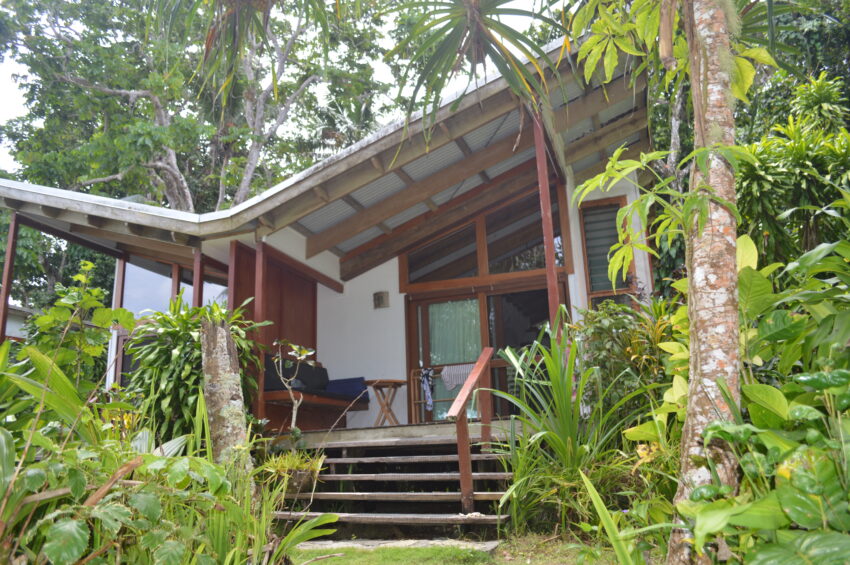
As traveling surfers, we are often accustomed to withstanding minimal conditions in exchange for good waves; it is an indirect sustainable sacrifice that appeals to die-hards. My quest was to find a middle ground suited for adventure types, relaxation, or families.
After a scenic drive, I arrived at Matanivusi Eco Resort situated just steps from the water’s edge, where I was greeted by a rich welcoming staff from the main lounge. The structures were fabricated from lustrous wood and built on a raised foundation to prevent water damage.
The walkway to each room was nestled within the growth of aged roped trees, monstera leaves and tropical leaves a meter in length. The rooms had large decorative fans for cooling and their private path a few footsteps to the white sandy beach.
Fiji: An exchange of sustainable and cultural practices
Within 30 minutes of settling in, I eagerly unloaded my board bag on the front deck of my room and attempted to snap the fins into my surfboards.
After a failed struggle and a few swear words under my breath later, Wisea Bisi, nicknamed Wise, appeared from working under the structure. We became fast friends when he completed the readiness of my favorite board with an easy-going nature.
Wise, 51, is an avid fisherman with a fearless nature. He became accustomed to diving in the evening when the fish are resting closer to shore. The resort manager said he was one of the longest employees of Matanivusi.
After a few days of sore ribs from paddling, I skipped an afternoon surf session and asked Wise for a tour of their methods in ecological conservation.
At first glance, it’s easy for visitors to miss the details of the structures. Wise drew my attention to repurposed elements of driftwood placed in the pole of the outdoor shower head.
When the resort was first constructed, the owners hired an architect to design the resort within the natural growth of the tropical scenery.
Wise reminisced about how many coconut trees have remained in place since the early construction in 2005, “we tried to build the buildings in between these trees and flowers.”
Worms Handle the Waste
Along the route, Wise pointed out the solar panels that replaced diesel generators in 2015, rainwater collection structures, and explained the resort’s toilet waste management system.
Ironically, the waste system intrigues the curiosity of many guests as its functionality depends on the existence of New Zealand worms.

These natural worm composters will convert human waste into manure for plants in the jungle. Posted in the resort’s powder rooms are creatively written cards that indicate paper disposal in allocated bins for “wee sittings,” since the worms have trouble processing excess toilet paper.
“I know that what I learned from here, it’s been growing, and I told that good story to my family,” said Wise who currently lives in Vunaniu, the local village.
As his family is located in distant areas, they too have adopted the habits of sorting and recycling plastic, cans, and tin cans. His family members noticed how their neighbors observed what they were doing and emulated the same practices.
Wise said it’s not just the practices of one single eco-resort, but changing Fiji as a whole, by teaching the young people as the next generation to preserve the island’s natural ecosystems.
He continued to explain how tourists come from different backgrounds where practicing sustainability is scarce due to busy work schedules. In turn, they have said to him, “we learned lots of things from you, (Wise), your story and we learned that we are supposed to do the same.”
As we concluded our tour with a walk along the beach, he described how the various foliage had holistic properties in their leaves and roots for skin, immune system health, and herbal remedies for cold and COVID. I soon realized why he was given the nickname, Wise.
With both Fijian and Hindi parents, resort manager Tony Karan said the villagers came to the resort and noticed how the shoreline had receded and was growing higher in evaluation in 2016. Karan said, “we’ve lost the land and we kind of get the same fish that our children and our grandchildren won’t be seeing.”
In Fiji, all villagers must agree before a change occurs. With the alliance of the resort, both parties attended a council meeting where they were awarded a temporary marine reserve in front of the bay of the resort.
The children in the village of Vunaniu are raised with a new awareness of what is happening to their home, they have quickly become conscious of litter and proper trash disposal from a very early age.
Surfing Fiji
The duration of my week’s stay was extremely quiet from the crowds of tourists. I shared my boat rides with only two Australian guests during the first two days and a paramedic in his early 20s from Sydney during my last two days.
We gathered every morning around 7 a.m. at the water’s edge and climbed aboard a panga boat with just our sunscreen, boards, hats, and water. During this time of the year, the water temperatures reach about 84 degrees and the tail end of the rainy season provides waves for intermediate to expert surfers.
Seva, a Fijian father of two young children was the main surf guide whose perfect barrel riding techniques were as impressive for being a self-taught surfer in an ocean of live shallow coral reef bottoms.
He had an athletic stature with broad shoulders with a quiet demeanor whose sense of humor came out as the hours accumulated in the water.
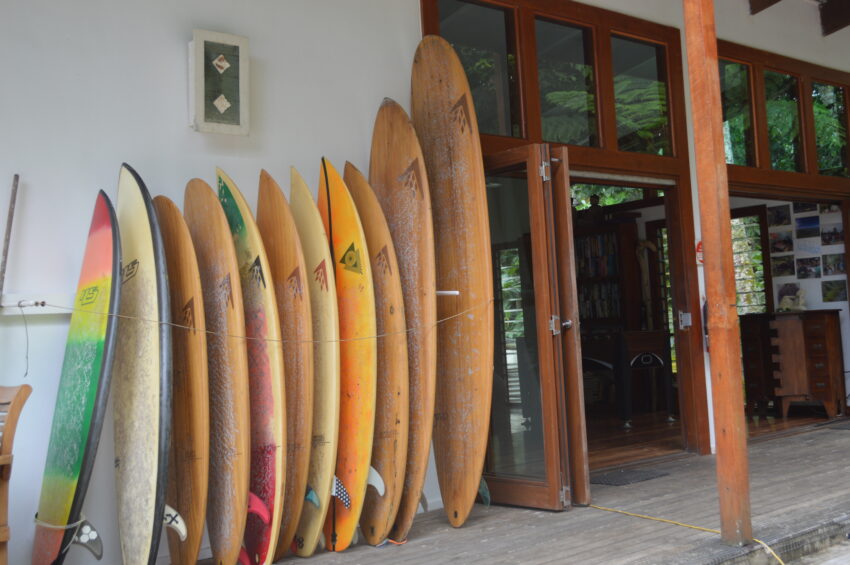
On a day trip out to Frigate’s surf break, a famous long left-handed wave, we drove a larger boat with a canopy out to sea viewing bright purple, orange and blue coral heads in the water below.
Seva informed us about the hand signals used in the event of an accident or broken leash. As we paddled hard into the fast churning waves he showed us where to position ourselves in the line-up and always encouraged us to “pull in” to the barrel.
After 20 years of surfing the forgiving ocean bottoms of Southern California, I appreciated the expert advice.
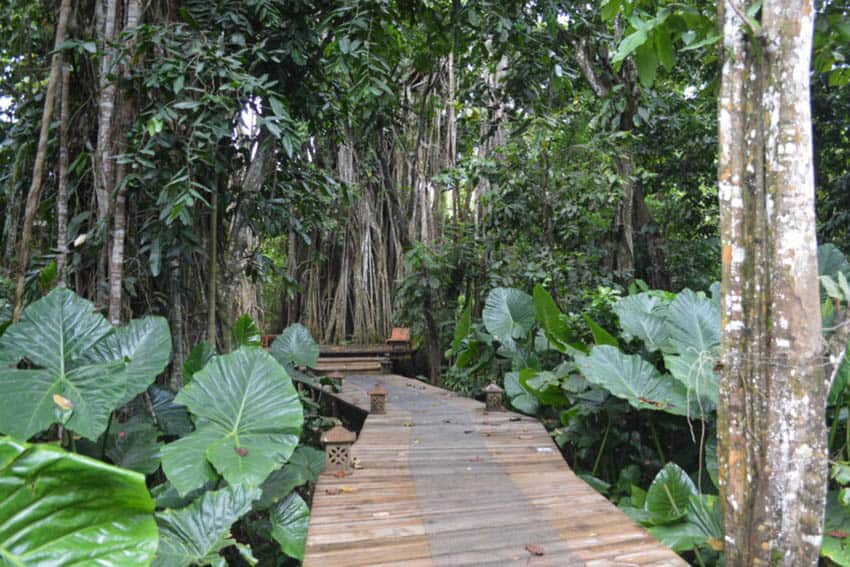
Every day was on repeat for fishing, snorkeling, kayaking, paddleboarding, river floating and surfing. Admittingly, with only so many daylight hours I spent the majority of my time surfing with Seva, who I named my “hype coach.” for pushing me out of my comfort zone.
With every boat ride, we looked at each other bright-eyed as we shared similar emotions of clear waters and picturesque green landscapes that gave the island a true untouched feeling.
When the boats arrive at the frequent surf spots, one of the two guides will sit at the bow and tie a rope to a stationary buoy installed by the resort to prevent reef damage from the daily use of anchors. I never saw trash in the ocean, just a few coconuts drifting in the water.
In the water, I asked another Fijian surf guide, Morgan, how long it takes for a patch of reef to recover after it has been pierced or stepped on, he replied, “ages, it takes ages.” That was enough for me to practice my starfish dismount after each wave.
The last two nights in the water at my favorite right-hander named J’s felt similar to surfing with longtime friends. Seva and Morgan cracked jokes and sang aloud while the young Australian and I laughed knowing we both made lifelong memories.
Fiji’s Progress
Matanivusi became the world’s first sustainable surf resort when a student from California State University of San Diego came to the resort and developed criteria for STOKE Certified’s evaluation process. The San Diego-based company is a certification association for sustainable surf and snow accommodations.
Owner Brian McDonald said after they received the benchmark, “we had an idea of what they were looking for and how we stood at sort of ground zero.” The resort worked its way up to operating 80 percent sustainably, McDonald, an Australian native, said it is common to plateau and it becomes challenging to raise the percentage.
“In the old days they (developers) would just go in and erase the places and build a big concrete monstrosity of a resort with all the trimmings that people see as five-stars,” McDonald said.
“That was the old model and everybody realizes that just can’t go on, it’s unsustainable. We’ve gone from being eco, you know, tree huggers, hippies, and loving the environment. Now looking at it in a realistic way where it’s sustainable and it’s not just the environment, it’s everything else.”
Venturing into the Capital, Suva

On my last day in Fiji, I awoke at 5:30 a.m. to venture to the capital of Suva to gain another perspective of Fiji’s efforts in sustainable tourism. I met with Marita Manley, a British owner of Talanoa Treks, a hiking company that commits to cultural and on-foot experiences through the unbeaten path.
“In Fiji, there is a very deep spiritual connection between ocean and land and sky and people have a very strong cultural identity to their, their place of birth to kin across the country,” Manley said. “I think most visitors when they stay in large resorts, don’t tend to leave their resorts and they don’t get to see that side of the country.”
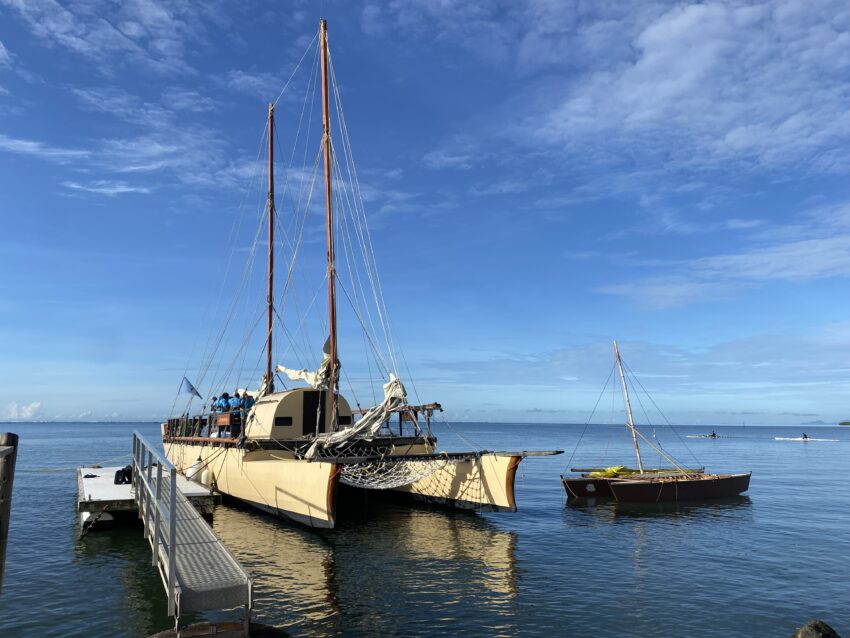
Sailing a Traditional Fijian Canoe
Although Manley’s company is temporarily closed due to COVID-19, she actively works as the secretary of Duavata, a sustainable tourism collective of accommodations in the Fijian islands. We met at the Sailing Center for the final leg of the Duavata Conservation Leadership Programme where participants ages 16 to 25 joined the non-profit Uto ni Yalo Trust Crew for a day out on a traditional 72-foot double-hulled Fijian canoe called a drua.
The program is geared to spread the idea of “Vanua” or stewardship over the land to protect it as a new generation. The group gathered on the Uto Ni Yalo which translates to ‘Heart of the Spirit’ to give exposure to sustainable sea transportation through the traditional lens of boat construction, navigation, and voyaging.
“The little Drua’s (boats) are part of Fuji’s heritage, and yet there are very few of these in the country, you know, for me, every resort in the country should have one of these and should be teaching guests,” Manning said. She continued that these vessels facilitate how early Fijians arrived, traded with Samoa and Tonga, and were used for war.
As the young leaders sailed away in a four-hour experience, Manley added that she has noticed that tourists are seeking out new experiences to be out in the ocean or the forest. As people look to travel as a way of reflection, Manley said, “I think people are thinking a lot more about why they’re traveling, which is good.”
 Andrea Clemett is a Los Angeles native and freelance journalist focusing on the environment and travel. She is an active contributing writer for the San Clemente Times, reporting about local businesses, community, and green issues. When she’s not chasing stories, she can be found catching waves around the world.
Andrea Clemett is a Los Angeles native and freelance journalist focusing on the environment and travel. She is an active contributing writer for the San Clemente Times, reporting about local businesses, community, and green issues. When she’s not chasing stories, she can be found catching waves around the world.
- Missouri Sports Travel Adventure: From Landmarks to Ballparks - January 21, 2026
- What First-Time Visitors Get Wrong About Visiting Iceland - January 15, 2026
- Bareboat Charter vs all-inclusive Crewed: Which Luxury Charter Fits You? - December 29, 2025




